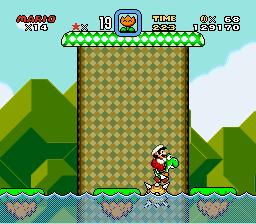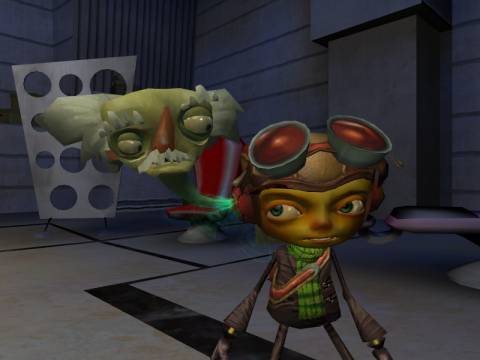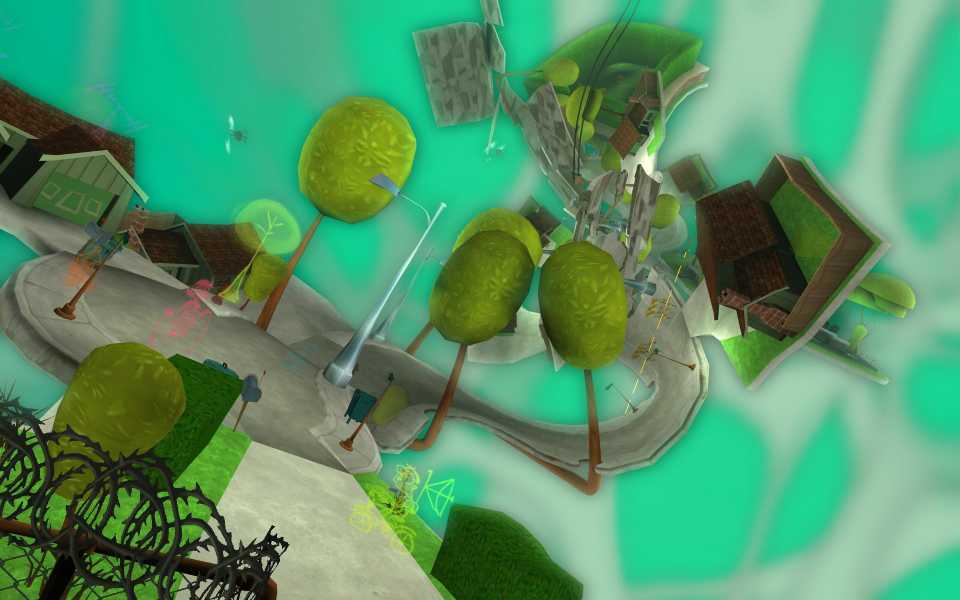Hey everyone, another summer mean another game-analysis essay. This one was written for the game design course that I decided to take for fun (which ended up getting me a job with the professor!!) so it's more focused on design than my previous work.
Anyways, enjoy!
Geometric Psychoses: Level Design in Psychonauts
When critically examining video games, much of the focus is often reserved for the game’s narrative and mechanics, with little attention paid to the design of the levels themselves. Through the effective use of level design, players can actually experience those same narratives and mechanics in much more effective and interesting ways than they may have otherwise. Double Fine Productions’ first game, Psychonauts, uses the design of its levels as an extension of its characters’ personalities, with each level using its environment and geometry to depict a different type of psychological state or illness. The game’s levels portray their various psychoses through a blend of both visual and mechanical techniques, which we will examine through the designers’ portrayals of repression in the level Sasha’s Shooting Gallery, and paranoid schizophrenia in The Milkman Conspiracy. In addition to this, the variations in level design allow the creators to change players’ perceptions of the games mechanics, which is best seen in the Lungfishopolis and Waterloo World levels.
In order to fully appreciate and analyze the impact that level design can have on a game we must first define what constitutes a level. In their analysis of two-dimensional platforming games, Smith, Cha, and Whitehead state that “Levels are the space where a player explores the rules and mechanics of a game” (Smith, Cha and Whitehead). By using this definition, we can extrapolate that the purpose of good level design is to allow players to experience the game’s mechanics in a variety of different ways. These critics present a model that separates game levels into two categories: Cells and Portals, where cells represent sections of linear gameplay and portals represent the links between those cells. To give an example, consider a hallway with two doors, where each door leads to a separate room. The hallway and rooms would be cells, with the doorways representing portals that connect them. Cells themselves can be further broken down into sequences of linear gameplay known as rhythm groups, with each rhythm group being marked by some sort of safe area where the player can rest before continuing the level. When using this model to examine a two-dimensional platformer, Smith, Cha, and Whitehead state that individual rhythm groups can be made up of Platforms, Obstacles, Movement Aids, Collectibles, or Triggers (Smith, Cha and Whitehead). To elaborate, Platforms refer to any object that the player can stand, run, or jump on, Obstacles are any object that can impart damage to the player’s avatar, Movement Aids change the way players traverse the level, Collectibles provide rewards such as coins or power-ups, and Triggers change the state of the level.

While Smith, Cha, and Whitehead’s analysis of levels may be excellent for the platforming genre, it is important to note that it does have limitations. When simply looking at this model from a mechanical standpoint, it is clear that it cannot be used to analyze all genres of games. For example, a racing game is not likely to have platforms beyond the race track itself or a puzzle game may not have need for movement aids. Despite these shortcomings, this framework still provides an excellent starting point for an analysis of how game mechanics and level design interact, which is also its primary shortcoming. In focusing solely on the mechanical aspects of level design, Smith, Cha, and Whitehead’s eschew any influence that level design may have on the game’s aesthetics and storytelling, or vice versa. It is important that level designers should focus on mechanics as well as “Things such as color theory, aesthetic quality, lighting, architecture and landscape” (Galuzin). As game development techniques advance, designers may find increasingly interesting ways to use level design as a key tool to communicate their game’s message or theme. From a purely mechanical standpoint, this model can be easily adapted to analyze a three-dimensional action-adventure game such as Double Fine’s Psychonauts, since the genre is largely an evolution of the traditional platformer. The game relies heavily on platforming segments to traverse the world, and players will face many obstacles that are familiar to the older genre such as pits and enemies. There are also movement aids such as ladders that assist players in their traversal and a wealth of collectibles which impart a variety of bonuses. About the only piece of the established framework that does not appear in Psychonauts are triggers, though it is easy to imagine ways that they may have been implemented into the game. Some levels do change in state, such as the enemies that appear at nighttime in the campground, however these state changes are beyond the player’s control. Where Psychonauts truly excels is in its blending of game mechanics with characterization through level design. Each of the games levels, with the exclusion of the open campground area, take place inside the minds of its characters, and as a result are used to depict their various mental states through both their mechanics and aesthetics.
One of the game’s early levels, Sasha’s Shooting Gallery, uses its level design to depict the Freudian theory of repression. Freud sees repression as “a consciously intended forgetting, [or] a specific unconscious mechanism of defense” (Zepf), and this theory is fully embraced throughout the level. Sasha’s Shooting Gallery takes place inside the mind of Sasha Nein, a German man who always appears calm and collected. His mindscape reflects this outward facade as it initially appears to be simply a giant featureless cube. Like its owner’s outwards appearance, this cube is both mechanically and aesthetically dull. As events unfold, Sasha’s mind begins to unravel, and the player begins to see aspects of his repressed psyche. All the aspects of his life that he has tried to suppress, primarily his childhood memories, spring forth from within the cube and form the actual layout of the level. Where once there was a flat cube face now we find all of the mechanical aspects of Smith, Cha and Whitehead’s model, such as platforms, enemies, and collectibles. In addition to rendering this level more mechanically interesting, all of these elements are aesthetically themed after the notion of Sasha’s repressed childhood. Players complete platforming segments where they jump off of items such as old shoeboxes, measuring tapes, and a ratty old mattress on a twisted metal bed frame. These thematic elements in the level may go unnoticed to some players; however they paint a clear picture of the childhood, or rather lack of a real childhood, which defines this character. This is also the first level that introduces the players to one of the game’s primary obstacles, the censors. Thematically these are also an appropriate element which fits into the game’s depiction of psychological repression. The narrative justification of the censors is that they seek to rid the mind of any elements which do not belong there. Not only is this the first appearance of these repressive enemies, but it is also one of the only levels that features an endlessly generated supply of them. This aspect serves mechanically to give the players as much time as they need to learn the game’s combat mechanics, while thematically representing a mind that is completely focused on suppressing undesirable elements as a defense mechanism. It is also worth noting that if the player decides to return to this level after having completed it they receive a short cutscene explaining that the outburst of memories from within the tightly packed cube of Sasha’s mind was in fact a planned part of the player’s training. While this may be true, it does not change the way that the repressed material is depicted, which influences the design and aesthetic of the level.

When examining the influence of psychoses that appears in the level designs of Psychonauts it is impossible not to mention The Milkman Conspiracy. This level is set inside the mind of Boyd Cooper, an asylum guard who suffers from paranoid schizophrenia, an illness which is heavily represented throughout the level’s design. This disorder is “a type of mental illness in which a person cannot tell what is real from what is imagined. At times, people with [this] psychotic disorder lose touch with reality. The world may seem like a jumble of confusing thoughts, images, and sounds” (WebMD). This last part of the definition is essential in examining the influence that this psychosis has on level design, since the layout of the level is designed to be extremely confusing. The laws of physics are abandoned almost entirely, and instead players traverse platforms that bend over on top of each other, slide across telephone wires to other areas that are perpendicular to the previous one, and generally disregard conventional notions of geometry and gravity. It is also important to recognize that sufferers of this disorder are known for being “preoccupied with false beliefs (delusions) about being persecuted or being punished by someone” (WebMD). This aspect is represented in the game through both its platforms and obstacles. Due to this level’s tendency to have platforms turn over themselves, players can frequently see other areas of the level from perspectives that should not be possible. For example, while standing on a rooftop the player may be able to look up into the sky and see into the yard of another house as if they were looking down on it from above. This aesthetic element of the design conveys a feeling of voyeurism for the player, letting them see things from perspectives that they shouldn’t have access too, while also giving them the feeling that they themselves could be being watched by someone else. This level also introduces players to an obstacle known as the G-Men, who appear to be comical depictions of spies. These enemies appear all over the level, and attempt to act as if they were normal people, only occasionally revealing their true intentions by quickly taking a photograph of something. Mechanically they are designed to impede the player’s progression, however thematically they fill the role of the paranoid schizophrenic’s unknown persecutor. This notion of being watched fills the whole aesthetic of the level, with even static elements of the level such as cars or garbage bins occasionally having cameras appear out of them. This unified theme of surveillance is depicted through both the mechanics of the level as well as its aesthetics to properly portray Boyd’s mental illness.
Aside from its depictions of various psychoses, Psychonauts also uses its inventive level design and aesthetics to reinvigorate the game’s mechanics, as we can see in the Lungfishopolis level. Since this level takes place inside the mind of a fish, the player’s avatar is rendered proportionally to its host, resulting in what appears to be a towering character stomping through a tiny city as if they were a giant monster. Despite this level feeling quite different from the rest, the feeling is achieved without any substantial changes to the game’s mechanics, and is primarily accomplished through level design. Players will traverse similar rhythm groups to what they have experienced earlier in the game. There are sections of platforming, where players must jump between several objects, or combat scenarios where players use the same skills that they learned previously to defeat enemies. For this level, the designers simply made adjustments to the game’s aesthetics as well as its pacing. Hullet and Whitehead describe pacing as “the overall flow of a level resulting from raising or lowering tempo, tension, challenge, or difficulty throughout the level” (Hullett and Whitehead). In the game’s previous levels, players rarely faced more than a mere handful of enemies that took a few hits to defeat, but here they must fight significantly more enemies at once. Most of these enemies can be destroyed in one strike, with the player sometimes destroying several at once, giving them a greater feeling of power over their obstacles. Aesthetically, all of the models in the level are rendered in miniature. Rather than simple platforms for the players to traverse, they are climbing large buildings or bouncing off of blimps. The enemies are similarly depicted as tiny little tanks, boats, etc… which are hardly larger than the player’s foot. Because of the changes in pacing, the rhythm groups of this level also appear to be longer, with players rarely finding areas where they can safely rest between bits of platforming and combat. This lends a sense of urgency to the player’s traversal of the level, and also gives the illusion that they are travelling through the world much more quickly due to its small scale.
Another section that effectively changes the player’s perception of the game’s mechanics through level design is the board-game inspired Waterloo World. Taking place in the mind of Fred Bonaparte, a distant descendant of Napoleon, this level changes the player’s objectives to depict what is essentially a turn-based strategy war game. The player descends into this game, as it is being played between Fred and Napoleon, and is tasked with helping the man defeat his ancestor. In order to accomplish this, players must move around the board themselves, accomplishing various tasks and moving Fred’s pieces along a hex-grid. Again the rhythm groups of this level remain similar to what players have already experienced to ensure that they do not feel confused. They still run and jump between platforms, fight enemies, and collect collectibles. To give the illusion of the board-game’s turn-based mechanics, the pacing is slowed almost completely to a halt, since the main enemy only moves his pieces after the player has moved theirs. Contrary to the Lungfishopolis level, players have the opportunity to rest just about anywhere that they wish, resulting in far shorter rhythm groups which turn the level into more of a puzzle game than an action game. Aesthetically, this level is the complete opposite of Lungfishopolis, with everything being rendered much larger than the player. This gives them the impression that they are one of the many small pieces of this board game, and successfully unifies the visuals of the level with the changes in pacing to give the desired illusion of different mechanics.

Despite its limitations, Smith, Cha, and Whitehead’s model for examining platformer games provides an excellent departure point for the analysis of level design. Mechanically, Psychonauts plays with the concepts of rhythm groups and pacing to establish a variety of different perceptions of its mechanics. This is best represented in the Lungfishopolis level, where players are given the illusion of being a giant monster destroying a city, and Waterloo World, which takes on the feel of a turn-based board-game. Not only can the effective use of level design give the appearance of different game mechanics, it can also be used to infuse the geometry of the world itself with narrative significance. With each of their levels, Double Fine depicts some varying form of mental illness, such as repression in Sasha’s Shooting Gallery or paranoid schizophrenia in The Milkman Conspiracy. Psychonauts serves as a perfect example of how the proper integration of level design into the mechanics, narrative, and aesthetic of a game can result in a much more profound and memorable experience.
Works Cited
Galuzin, Alex. "Why I Failed for Years at Level Design and Game Environments." 29 November 2011. World of Level Design. 21 February 2013.
Hullett, Kenneth and Jim Whitehead. "Design patterns in FPS." FDG (2010).
Smith, Gillian, Mee Cha and Jim Whitehead. "Level Design and Mechanics." ACM Sandbox (2008).
WebMD. "Schizophrenia: An Overview." 2005. WebMD. 12 04 2013.
Zepf, Siegfried. "Repression and Substitutive Formation: The Relationship Between Freud's Concepts Reconsidered." The Psychoanalytic Review 99.3 (2012): 397-420.
Log in to comment